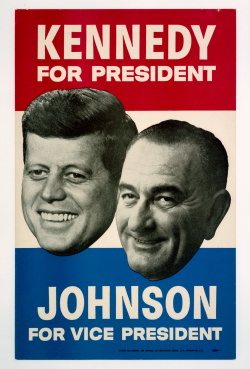Timeline: LBJ and the Nation
1908-1919 1920-1929 1929-1940 1941-1945 1946-1953 1954-1960 1960-1963 1963-1969 1969-1973
1954-1960
The United States and the Soviet Union confronted each other across the nightmare threat of mutual extinction, both armed with unprecedented power. But even as the tension mounted through the 1950s, the weapons stayed sheathed, and under the uneasy truce of nuclear deterrence, life went on. However U.S.S.R. Premier Nikita Khruschev added a new dimension of danger to the cold war by declaring Soviet support for uprisings, which he called “wars of national liberation.”
Republican Dwight D. Eisenhower’s inauguration as president ushered in an era of apparent calm in the nation's life. The war in Korea, of which the country had grown increasingly weary, came to an inconclusive end by armistice. After the upheaval of war, the nation began to relax. But beneath the placid exterior problems festered. The appearance of affluence masked the fact that millions of Americans lived in poverty. The long pent-up demand by African Americans for full citizenship built, and began to erupt.
When the Democrats gained control of the Senate in 1955, Johnson became majority leader, and in 1957 he steered through the Senate a civil rights bill.
The young woman who once hoped her husband's career would not be in politics grew to enjoy fully life in the excitement of the Senate.
Events
Civil Liberties and Civil Rights
In the early 1950s, Senator Joseph McCarthy's attacks that played on the public's fear of Communist subversion threatened American civil liberties. In 1954 Johnson was instrumental in getting the Senate to appoint a select committee to determine whether McCarthy should be censured, the beginning of McCarthy's downfall.
Rosa Parks, a black seamstress in Montgomery, Alabama, protested the city's segregation policy by refusing to give her bus seat to a white passenger. Black citizens launched a bus boycott, led by a young minister named Martin Luther King, Jr. The boycott lasted for 382 days and broke the pattern of segregated transportation.
In Little Rock, Arkansas, color barriers tumbled dramatically when black children, responding to the Supreme Court's historic decision that segregated schools were unconstitutional, endured the hostility of some of their neighbors in pursuit of integrated education.
In 1957, Majority Leader Johnson steered through the Senate a civil rights bill, the first in eight years.
SEATO and Vietnam
The SEATO treaty, ratified eighty-two to one by the Senate in 1955, promised that, in case of aggression against its members as well as the "protocol states" (Laos, Cambodia, and South Vietnam), the U.S. would "act to meet the common danger in accordance with its constitutional processes." Signed by Dwight D. Eisenhower, later administrations cited it as justification for America's involvement in South Vietnam.
A shadow that would fall far into the future was cast in Southeast Asia when the French, who had colonized Vietnam for a hundred years, were driven out of that country and Vietnam was left divided by treaty.
Space Exploration
The Russians launched Sputnik ("fellow traveler"), the first artificial earth satellite, on October 4, 1957. Johnson assembled his Preparedness Subcommittee to determine how the U.S. could catch up and overtake the Soviets. His interest and activity soon identified him as a leader in the emerging area of space exploration.
Lyndon Baines Johnson
When the Democrats gained control of the Senate in 1955, Johnson became majority leader. He established a close working relationship with Republican Proport most of the administration's foreign policy. Despite the slim majority, Johnson skillfully managed legislation, becoming, in the judgment of many, the most effective leader in Senate history. His legendary style of leadership was a combination of personal persuasion, intimate knowledge of fellow senators, mastery of detail, and an impeccable sense of timing.
One memorable alliance forged in the Senate was between the pragmatic Johnson and Hubert Humphrey, leader of the liberal forces.
The tension, strain, and toil of the job caught up with the Majority Leader, who suffered a major heart attack in 1955. His forty-seventh birthday found him recuperating at the ranch with his family.
The tension, strain, and toil of the job caught up with the Majority Leader, who suffered a major heart attack in 1955. His forty-seventh birthday found him recuperating at the ranch with his family.
In 1957 Majority Leader Johnson steered through the Senate a civil rights bill. It was a compromise measure, more important as a symbol than for substance. His skill at accommodating both factions was respected by liberals and conservatives alike. Johnson's record on civil rights to this point had been mixed.
Although personally opposed to segregation as a hindrance to Southern progress, and with a history of working to improve the lives of Texas blacks since his National Youth Administration days, as a senator he nonetheless had generally voted with the Southern bloc on racial issues. He now was closely identified with the civil rights bill, however, and that transformed him from a regional into a national figure.
Lady Bird Johnson
The young woman who once hoped her husband's career would not be in politics grew to enjoy fully life in the excitement of the Senate, being an "eyewitness," as she would later say, to much of the history being made.
In a 1955 letter, Lady Bird's interest in wildflowers, which began in her childhood, continued.

